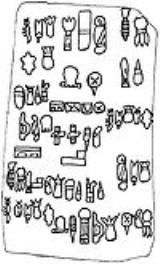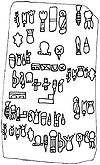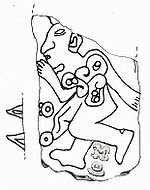
Mesoamerican writing systems
Encyclopedia
Mesoamerica
, like India
, Mesopotamia
, China, and Egypt, is one of the few places in the world where writing has developed independently. Mesoamerican scripts deciphered to date are logosyllabic, combining the use of logograms with a syllabary
, and they are often called hieroglyphic scripts. Five or six different scripts have been documented in Mesoamerica but archaeological dating methods make it difficult to establish which was earliest and hence the forebear from which the others developed. The best documented and deciphered Mesoamerican writing system, and hence the most widely known, is the classic Maya script
. An extensive Mesoamerican literature
has been conserved partly in indigenous scripts and partly in the postconquest transcriptions in the Latin script.

Early Olmec ceramics show representations of something that may be codices, suggesting that amatl
bark codices, and by extension well-developed writing, existed in Olmec times. It was also long thought that many of the glyphs present on Olmec monumental sculpture, such as those on the so-called "Ambassador Monument" (La Venta Monument 13), represented an early Olmec script. This suspicion was reinforced in 2002 by the announcement of the discovery of similar glyphs at San Andres
.
In September 2006, a report published in Science magazine
announced the discovery of the Cascajal block
, a writing tablet-size block of serpentine
with 62 characters unlike any yet seen in Mesoamerica. This block was discovered by locals in the Olmec heartland
and was dated by the archaeologists to approximately 900 BCE
based on other debris. If the authenticity and date can be verified, this will prove to be the earliest writing yet found in Mesoamerica.

culture. Rising in the late Pre-Classic era
after the decline of the Olmec civilization, the Zapotecs of present day Oaxaca built an empire around Monte Alban
. On a few monuments at this archaeological site, archaeologists have found extended text in a glyphic script. Some signs can be recognized as calendric information but the script as such remains undeciphered. Read in columns from top to bottom, its execution is somewhat cruder than that of the later Classic Maya and this has led epigraphers to believe that the script was also less phonetic than the largely syllabic Mayan script. These are, however, speculations.
The earliest known monument with Zapotec writing is a "Danzante" stone, officially known as Monument 3, found in San Jose Mogote
, Oaxaca
. It has a relief of what appears to be dead and bloodied captive with two glyphic signs between his legs, probably his name. First dated to 500–600 BCE, this was earlier considered the earliest writing in Mesoamerica. However doubts have been expressed as to this dating and the monument may have been reused. The Zapotec script went out of use only in the late Classic period.

show examples of another early Mesoamerican writing system. They can be seen to contain calendric information but are otherwise undeciphered. The longest of these texts are on La Mojarra Stela 1
and the Tuxtla Statuette
. The writing system used is very close to the Mayan script, using affixal glyphs and Long Count dates, but is read only in one column at a time as is the Zapotec script. It has been suggested that this Isthmian or Epi-Olmec script is the direct predecessor of the Mayan script, thus giving the Mayan script a non-Mayan origin. Another artefact with Epi-Olmec script is the Chiapa de Corzo stela which is the oldest monument of the Americas inscribed with its own date: the Long Count on the stela dates it to 36 BCE.
In a 1997 paper, John Justeson and Terrence Kaufman put forward a decipherment of Epi-Olmec and leading, in 2003, to a Guggenheim Fellowship for this work. The following year, however, their interpretation was disputed by Stephen Houston and Michael D. Coe, who unsuccessfully applied Justeson and Kaufman's decipherment system against epi-Olmec script from the back of a hitherto unknown mask. The matter remains under dispute.
writing has been found dating to Izapa
n culture. It is likely that in this area in late Pre-Classic times an ancient form of a Mixe–Zoquean language was spoken, and the inscriptions found here may be in such a language rather than a Mayan one. Some glyphs in this scripts are readable as they are identical to Mayan glyphs but the script remains undeciphered. The advanced decay and destruction of these archaeological sites make it improbable that more monuments with these scripts will come to light making possible a decipherment.

and La Cobanerita in El Petén, Guatemala
. And the most elaborate inscriptions are considered to be those at classic sites like Palenque
, Copán
and Tikal
.
The Maya script
is generally considered to be the most fully developed Mesoamerican writing system mostly because of its extraordinary aesthetics and because it has been deciphered. In Mayan writing, logograms and syllable signs are combined. Around 700 different glyphs have been documented, with some 75% having been deciphered. Around 7000 texts in Mayan script have been documented.
 After the collapse of the Classic Maya civilization, the Mayan glyphic system continued to be used but much less so. Post-Classic inscriptions are found at the Yucatán peninsula in sites such as Chichén Itza
After the collapse of the Classic Maya civilization, the Mayan glyphic system continued to be used but much less so. Post-Classic inscriptions are found at the Yucatán peninsula in sites such as Chichén Itza
and Uxmal
but the style is not nearly as accomplished as the Classic Mayan inscriptions. Other Post-Classic cultures such as the Aztec
did not have developed writing systems at all, but instead used semasiographic writing although they have been said to be slowly developing phonetic principles in their writing by the use of the rebus
principle. Aztec name glyphs for example do combine logographic elements with phonetic readings.
Mesoamerica
Mesoamerica is a region and culture area in the Americas, extending approximately from central Mexico to Belize, Guatemala, El Salvador, Honduras, Nicaragua, and Costa Rica, within which a number of pre-Columbian societies flourished before the Spanish colonization of the Americas in the 15th and...
, like India
Indus script
The term Indus script refers to short strings of symbols associated with the Indus Valley Civilization, in use during the Early Harappan and Mature Harappan period, between the 35th and 20th centuries BC. In spite of many attempts at decipherments and claims, it is as yet undeciphered...
, Mesopotamia
Cuneiform
Cuneiform can refer to:*Cuneiform script, an ancient writing system originating in Mesopotamia in the 4th millennium BC*Cuneiform , three bones in the human foot*Cuneiform Records, a music record label...
, China, and Egypt, is one of the few places in the world where writing has developed independently. Mesoamerican scripts deciphered to date are logosyllabic, combining the use of logograms with a syllabary
Syllabary
A syllabary is a set of written symbols that represent syllables, which make up words. In a syllabary, there is no systematic similarity between the symbols which represent syllables with the same consonant or vowel...
, and they are often called hieroglyphic scripts. Five or six different scripts have been documented in Mesoamerica but archaeological dating methods make it difficult to establish which was earliest and hence the forebear from which the others developed. The best documented and deciphered Mesoamerican writing system, and hence the most widely known, is the classic Maya script
Maya script
The Maya script, also known as Maya glyphs or Maya hieroglyphs, is the writing system of the pre-Columbian Maya civilization of Mesoamerica, presently the only Mesoamerican writing system that has been substantially deciphered...
. An extensive Mesoamerican literature
Mesoamerican literature
The traditions of indigenous Mesoamerican literature extend back to the oldest-attested forms of early writing in the Mesoamerican region, which date from around the mid-1st millennium BCE. Many of the pre-Columbian cultures of Mesoamerica are known to have been literate societies, who produced a...
has been conserved partly in indigenous scripts and partly in the postconquest transcriptions in the Latin script.
Olmec writing

Early Olmec ceramics show representations of something that may be codices, suggesting that amatl
Amatl
Amate is a form of paper that has been manufactured in Mexico since the pre Hispanic times. Amate paper was extensively produced and used for both communication, records and ritual during the Aztec Empire; however, after the Spanish conquest, its production was mostly banned and replaced by...
bark codices, and by extension well-developed writing, existed in Olmec times. It was also long thought that many of the glyphs present on Olmec monumental sculpture, such as those on the so-called "Ambassador Monument" (La Venta Monument 13), represented an early Olmec script. This suspicion was reinforced in 2002 by the announcement of the discovery of similar glyphs at San Andres
San Andrés (Mesoamerican site)
San Andrés is an Olmec archaeological site in the present-day Mexican state of Tabasco. Located 5 km northeast of the Olmec ceremonial center of La Venta, San Andrés is considered one of its elite satellite communities, with evidence of elite residences and other elite activities...
.
In September 2006, a report published in Science magazine
Science (journal)
Science is the academic journal of the American Association for the Advancement of Science and is one of the world's top scientific journals....
announced the discovery of the Cascajal block
Olmec hieroglyphs
The Cascajal Block is a writing tablet-sized serpentinite slab which has been dated to the early first millennium BCE incised with hitherto unknown characters that may represent the earliest writing system in the New World. Archaeologist Stephen D...
, a writing tablet-size block of serpentine
Serpentinite
Serpentinite is a rock composed of one or more serpentine group minerals. Minerals in this group are formed by serpentinization, a hydration and metamorphic transformation of ultramafic rock from the Earth's mantle...
with 62 characters unlike any yet seen in Mesoamerica. This block was discovered by locals in the Olmec heartland
Olmec heartland
The Olmec heartland is the southern portion of Mexico's Gulf Coast region between the Tuxtla mountains and the Olmec archaeological site of La Venta, extending roughly 80 km inland from the Gulf of Mexico coastline at its deepest...
and was dated by the archaeologists to approximately 900 BCE
Common Era
Common Era ,abbreviated as CE, is an alternative designation for the calendar era originally introduced by Dionysius Exiguus in the 6th century, traditionally identified with Anno Domini .Dates before the year 1 CE are indicated by the usage of BCE, short for Before the Common Era Common Era...
based on other debris. If the authenticity and date can be verified, this will prove to be the earliest writing yet found in Mesoamerica.

Zapotec writing
Another candidate for earliest writing system in Mesoamerica is the writing system of the ZapotecZapotec civilization
The Zapotec civilization was an indigenous pre-Columbian civilization that flourished in the Valley of Oaxaca of southern Mesoamerica. Archaeological evidence shows their culture goes back at least 2500 years...
culture. Rising in the late Pre-Classic era
Mesoamerican chronology
Mesoamerican chronology divides the history of pre-Columbian Mesoamerica into several periods: the Paleo-Indian , the Archaic , the Preclassic , the Classic , and the Postclassic...
after the decline of the Olmec civilization, the Zapotecs of present day Oaxaca built an empire around Monte Alban
Monte Albán
Monte Albán is a large pre-Columbian archaeological site in the Santa Cruz Xoxocotlán Municipality in the southern Mexican state of Oaxaca...
. On a few monuments at this archaeological site, archaeologists have found extended text in a glyphic script. Some signs can be recognized as calendric information but the script as such remains undeciphered. Read in columns from top to bottom, its execution is somewhat cruder than that of the later Classic Maya and this has led epigraphers to believe that the script was also less phonetic than the largely syllabic Mayan script. These are, however, speculations.
The earliest known monument with Zapotec writing is a "Danzante" stone, officially known as Monument 3, found in San Jose Mogote
San Jose Mogote
San José Mogote is a pre-Columbian archaeological site of the Zapotec, a Mesoamerican culture that flourished in the region of what is now the Mexican state of Oaxaca. A forerunner to the better-known Zapotec site of Monte Albán, San José Mogote was the largest and most important settlement in the...
, Oaxaca
Oaxaca
Oaxaca , , officially Estado Libre y Soberano de Oaxaca is one of the 31 states which, along with the Federal District, comprise the 32 federative entities of Mexico. It is divided into 571 municipalities; of which 418 are governed by the system of customs and traditions...
. It has a relief of what appears to be dead and bloodied captive with two glyphic signs between his legs, probably his name. First dated to 500–600 BCE, this was earlier considered the earliest writing in Mesoamerica. However doubts have been expressed as to this dating and the monument may have been reused. The Zapotec script went out of use only in the late Classic period.

Epi-Olmec or Isthmian script
A small number of artefacts found in the Isthmus of TehuantepecIsthmus of Tehuantepec
The Isthmus of Tehuantepec is an isthmus in Mexico. It represents the shortest distance between the Gulf of Mexico and the Pacific Ocean, and prior to the opening of the Panama Canal was a major shipping route known simply as the Tehuantepec Route...
show examples of another early Mesoamerican writing system. They can be seen to contain calendric information but are otherwise undeciphered. The longest of these texts are on La Mojarra Stela 1
La Mojarra Stela 1
La Mojarra Stela 1 is a Mesoamerican carved monument dating from the 2nd century CE. It was discovered in 1986, pulled from the Acula River near La Mojarra, Veracruz, Mexico, not far from the Tres Zapotes archaeological site. The by , four-ton limestone slab contains about 535 glyphs of the...
and the Tuxtla Statuette
Tuxtla Statuette
The Tuxtla Statuette is a small 6.3 inch rounded greenstone figurine, carved to resemble a squat, bullet-shaped human with a duck-like bill and wings. Most researchers believe the statuette represents a shaman wearing a bird mask and bird cloak...
. The writing system used is very close to the Mayan script, using affixal glyphs and Long Count dates, but is read only in one column at a time as is the Zapotec script. It has been suggested that this Isthmian or Epi-Olmec script is the direct predecessor of the Mayan script, thus giving the Mayan script a non-Mayan origin. Another artefact with Epi-Olmec script is the Chiapa de Corzo stela which is the oldest monument of the Americas inscribed with its own date: the Long Count on the stela dates it to 36 BCE.
In a 1997 paper, John Justeson and Terrence Kaufman put forward a decipherment of Epi-Olmec and leading, in 2003, to a Guggenheim Fellowship for this work. The following year, however, their interpretation was disputed by Stephen Houston and Michael D. Coe, who unsuccessfully applied Justeson and Kaufman's decipherment system against epi-Olmec script from the back of a hitherto unknown mask. The matter remains under dispute.
Abaj Takalik and Kaminaljuyú scripts
In the highland Mayan archaeological sites of Abaj Takalik and KaminaljuyúKaminaljuyu
Kaminaljuyu is a Pre-Columbian site of the Maya civilization that was primarily occupied from 1500 BC to AD 1200. Kaminaljuyu has been described as one of the greatest of all archaeological sites in the New World by Michael Coe, although its remains today - a few mounds only - are far less...
writing has been found dating to Izapa
Izapa
Izapa is a very large pre-Columbian archaeological site located in the Mexican state of Chiapas; it was occupied during the Late Formative period. The site is situated on the Izapa River, a tributary of the Suchiate River, near the base of the Tacaná volcano), the fourth largest mountain in...
n culture. It is likely that in this area in late Pre-Classic times an ancient form of a Mixe–Zoquean language was spoken, and the inscriptions found here may be in such a language rather than a Mayan one. Some glyphs in this scripts are readable as they are identical to Mayan glyphs but the script remains undeciphered. The advanced decay and destruction of these archaeological sites make it improbable that more monuments with these scripts will come to light making possible a decipherment.

Mayan writing
Mayan writing is attested from the mid-preclassic period in the center of Petén in the Mayan lowlands, and lately scholars have suggested that the earliest Mayan inscriptions may in fact be the oldest of Mesoamerica. The earliest inscriptions in an identifiably Maya script date back to 200–300 BCE. Early examples include the painted inscriptions at the caves of Naj TunichNaj Tunich
Naj Tunich is a natural cave and an important archaeological site in Guatemala.The discovery of the Naj Tunich caves, in Poptún southern Peten, Guatemala, in 1979 initiated the interest for Cave Archeology among Mayanists...
and La Cobanerita in El Petén, Guatemala
Guatemala
Guatemala is a country in Central America bordered by Mexico to the north and west, the Pacific Ocean to the southwest, Belize to the northeast, the Caribbean to the east, and Honduras and El Salvador to the southeast...
. And the most elaborate inscriptions are considered to be those at classic sites like Palenque
Palenque
Palenque was a Maya city state in southern Mexico that flourished in the 7th century. The Palenque ruins date back to 100 BC to its fall around 800 AD...
, Copán
Copán
Copán is an archaeological site of the Maya civilization located in the Copán Department of western Honduras, not far from the border with Guatemala. It was the capital city of a major Classic period kingdom from the 5th to 9th centuries AD...
and Tikal
Tikal
Tikal is one of the largest archaeological sites and urban centres of the pre-Columbian Maya civilization. It is located in the archaeological region of the Petén Basin in what is now northern Guatemala...
.
The Maya script
Maya script
The Maya script, also known as Maya glyphs or Maya hieroglyphs, is the writing system of the pre-Columbian Maya civilization of Mesoamerica, presently the only Mesoamerican writing system that has been substantially deciphered...
is generally considered to be the most fully developed Mesoamerican writing system mostly because of its extraordinary aesthetics and because it has been deciphered. In Mayan writing, logograms and syllable signs are combined. Around 700 different glyphs have been documented, with some 75% having been deciphered. Around 7000 texts in Mayan script have been documented.
Writing in post-classic cultures

Chichen Itza
Chichen Itza is a large pre-Columbian archaeological site built by the Maya civilization located in the northern center of the Yucatán Peninsula, in the Municipality of Tinúm, Yucatán state, present-day Mexico....
and Uxmal
Uxmal
Uxmal was dominant from 875 to 900 CE. The site appears to have been the capital of a regional state in the Puuc region from 850-950 CE. The Maya dynasty expanded their dominion over their neighbors. This prominence didn't last long...
but the style is not nearly as accomplished as the Classic Mayan inscriptions. Other Post-Classic cultures such as the Aztec
Aztec
The Aztec people were certain ethnic groups of central Mexico, particularly those groups who spoke the Nahuatl language and who dominated large parts of Mesoamerica in the 14th, 15th and 16th centuries, a period referred to as the late post-classic period in Mesoamerican chronology.Aztec is the...
did not have developed writing systems at all, but instead used semasiographic writing although they have been said to be slowly developing phonetic principles in their writing by the use of the rebus
Rebus
A rebus is an allusional device that uses pictures to represent words or parts of words. It was a favourite form of heraldic expression used in the Middle Ages to denote surnames, for example in its basic form 3 salmon fish to denote the name "Salmon"...
principle. Aztec name glyphs for example do combine logographic elements with phonetic readings.

